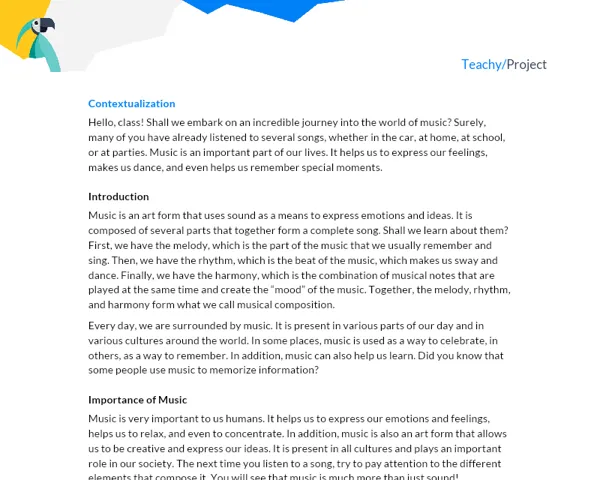Contextualization
Postmodernism, emerged in the mid-20th century, has a crucial importance in understanding the contemporary world, especially in the universe of Arts. This movement is a response to modernity and its ideologies, such as the ideal of progress, faith in reason, and scientific knowledge. In contrast, postmodernism questions the metanarratives, bringing to light pluralism, relativism, and deconstruction.
Postmodern Art is marked by a diversity of styles, techniques, and contents, and by the reinterpretation of works and styles from the past. It is common to see a mix of different styles and genres, intertextuality, kitsch, and questioning of the concept of originality and the role of the artist. The result is a rich, diversified, and complex field that challenges traditional definitions of art.
Postmodernist art, unlike modernist art, does not seek formal purity but the mixing of styles, techniques, materials, and images, including popular ones. It values the ephemeral, the disposable, the fragmented, parody, and pastiche. It questions the idea of originality, authorship, and the very concept of Art, using ready-mades and appropriations.
Considering the relevance of postmodernism in our society, an in-depth study on this topic is essential. Although it emerged in the 20th century, postmodernism continues to shape our lives, influencing various areas such as architecture, music, cinema, and, of course, visual arts. Postmodernism rejects grand narratives, proposing instead smaller, personal, and local stories, giving voice to previously marginalized groups.
Therefore, studying postmodernism in art is to understand the current artistic and cultural context, to perceive the intersections between popular and erudite art, to comprehend the critique of the concept of originality, and the value given to appropriation and reinterpretation.
As a resource to deepen your studies, we suggest the book 'The Postmodern Condition' by J.F. Lyotard, which is a theoretical landmark on the subject. Additionally, we recommend the website of the Itaú Cultural Institute (https://www.itaucultural.org.br/), which offers various articles and materials on artists and movements associated with postmodernism. For a more interactive experience, consider the Google Arts and Culture platform (https://artsandculture.google.com/), where you can explore postmodern artworks from museums around the world.
Practical Activity: 'The Voice of Postmodern Art'
Project Objective
The project aims to encourage students to explore, analyze, and reinterpret postmodern artworks, taking into account the main concepts of this phase: pluralism, relativism, intertextuality, and deconstruction.
Project Description
Students will work in groups of 3 to 5 people. Each group will choose a specific postmodern artwork to analyze in detail and, subsequently, create a reinterpretation of that artwork. The reinterpretation can be done in any medium chosen by the students (painting, sculpture, drawing, digital montage, etc.)
The estimated working time per student for the implementation of this project is 2 to 4 hours, and the project deadline is one week from the given moment.
Required Materials
- Internet access for research and/or books on Postmodern Art.
- Materials for creating the artwork: this will depend on the medium chosen by the group for the reinterpretation of the artwork. It can be paint, paper, clay, image editing software, among others.
Step by Step
-
Each group must research and select a postmodern artwork for analysis. It is important that the chosen artwork is significant to the group members and represents the key elements of the postmodernist movement.
-
After selecting the artwork, the group should research the historical-social context in which the artwork was created, the author, the technique used, the visual elements present, and the intention behind the artwork.
-
Based on the analysis, the group should create a reinterpretation of the chosen artwork. This reinterpretation should be an expression of the group's understanding of the artwork and the principles of postmodernism.
-
In addition to the reinterpreted artwork, the group should prepare a written report containing the following topics:
-
Introduction: Describe the relevance of studies on postmodern art and the specific objective of the project.
-
Development: Present the selected original artwork and why it was chosen. Explain the process of analysis and research on the artwork and the author. Discuss the creation process of the reinterpretation, including the chosen technique, the challenges encountered, and how they were overcome. Finally, present the reinterpreted artwork and the meanings attributed by the group members.
-
Conclusion: Summarize the main points of the project, the learnings obtained, and the conclusions drawn throughout the process.
-
Bibliography: Cite all research sources used.
-
Project Deliverables
The final project should include the reinterpreted artwork (or an image of it, in the case of three-dimensional or digital artworks) and the written report as described above. The artwork should be a direct reflection of the group's research and analysis process, while the written report should complement the artwork, offering a detailed view of the creative process, theoretical contextualization, and critical reflection of the students.
The project allows students to appropriate the concepts of postmodern art and practice skills such as collaboration, research, critical analysis, and creative expression. Through the written report, students also practice important skills in written communication and critical argumentation.

